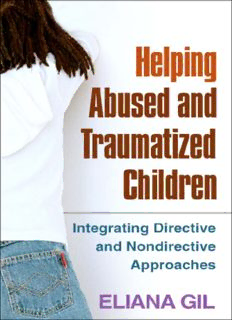
Helping Abused and Traumatized Children: Integrating Directive and Nondirective Approaches PDF
Preview Helping Abused and Traumatized Children: Integrating Directive and Nondirective Approaches
HELPING ABUSED AND TRAUMATIZED CHILDREN This page intentionally left blank Helping Abused and Traumatized Children Integrating Directive and Nondirective Approaches ELIANA GIL Foreword by John Briere THE GUILFORD PRESS New York London ©2006TheGuilfordPress ADivisionofGuilfordPublications,Inc. 72SpringStreet,NewYork,NY10012 www.guilford.com Allrightsreserved Nopartofthisbookmaybereproduced,translated,storedin aretrievalsystem,ortransmitted,inanyformorbyanymeans, electronic,mechanical,photocopying,microfilming,recording, orotherwise,withoutwrittenpermissionfromthePublisher. PrintedintheUnitedStatesofAmerica Thisbookisprintedonacid-freepaper. Lastdigitisprintnumber: 9 8 7 6 5 4 3 2 1 LibraryofCongressCataloging-in-PublicationData Gil,Eliana. Helpingabusedandtraumatizedchildren:integratingdirectiveandnondirective approaches/ElianaGil. p.;cm. Includesbibliographicalreferencesandindex. ISBN-10:1-59385-334-3 ISBN-13:978-1-59385-334-1(cloth) 1. Childabuse—Treatment. 2. Playtherapy. I. Title. [DNLM:1. ChildAbuse—therapy. 2. Child. 3. FamilyTherapy—methods. 4. PlayTherapy—methods. WS350.2G463h2006] RJ507.A29G5522006 618.92′891653—dc22 2006010324 Dr. William Friedrich, you were a man of great humility and integrity. I learned so much from you. Your quiet and powerful leadership has inspired and guided me. I am proud to have known you a little, exchanged ideas with you, and had a few laughs. I feel your absence and revere your substantial legacy. About the Author ElianaGil,PhD,isDirectoroftheStarbrightTrainingInstituteforChild and Family Play Therapy and dedicates some of her time to providing intensive courses on assessment and treatment of child abuse. She also worksattheMulticulturalClinicalCenterinSpringfield,Virginia,where sheisdevelopingTheChildren’sCornertoprovidementalhealthservices for young children with a range of problems, including child maltreat- ment. Dr.Gilhasfocusedherworkonhelpingsexuallyabusedchildren and families for the past 33 years in California, Maryland, and Virginia. She teaches courses on child maltreatment, play therapy, and family therapyatVirginiaTechandhasauthoredseveralbooks.Originallyfrom Ecuador, she is bilingual and bicultural. vi FFoorreewwoorrdd Foreword T helastseveraldecadeshavewitnessedadramaticincreaseinour knowledge of the impacts of trauma on children and adolescents. We have discovered that child abuse and neglect by parents and other caretakers—as well as victimization by peers and adults in the commu- nity—canleadtooutcomesrangingfromanxietyanddepression,insecure parent–childattachments,andposttraumaticstress,toaggression,interper- sonal problems, eating disorders, substance abuse, and self-endangering behaviors.Infact,itmaynotbetoomuchofaleaptosuggestthatexpo- sure to trauma and emotional neglect is one of the prime causes of nonorganic psychological disturbance in North American children and youth. At the same time, however, we have increasingly discovered that nothingisassimpleasacursoryreadingoftheliteraturemightsuggest. Forexample,wenowknowthattheextenttowhichachildoradolescent developstrauma-relatedsymptomsisacomplexfunctionofanumberof potentiallyinteractingvariables.Theseminimallyinclude(1)predisposing factors, such as the child’s initial neurobiology; the quality of his or her parentalattachments;broadersocialvariables,includingthechild’srela- tive experience of racial or ethnic discrimination, poverty, and dimin- ished resources; and cultural or subcultural influences on his or her per- ceptionsofself,others,andthenatureofadversity;(2)characteristicsofthe trauma(s), including the type, number, duration, and age of onset of trauma exposure—with multiple, early, and extended experiences of intrafamilialabuseandneglectbeingamongthemostpathogenic;and(3) posttrauma variables, such as overall level of familial and social support; vii viii Foreword the child’s capacity for emotional expression and help seeking; relative safety from further violence or maltreatment; and whether appropriate psychological treatment is available. Theimplicationsofthesevariousinteractingvariablesfortheyoung traumasurvivor—andforthosewhowouldtreathimorher—areimpor- tant.Becauseeverychildhas,tosomeextent,adifferentbiology,psychol- ogy, perceived family environment, social context, trauma history, and postvictimizationexperience,eachisalsolikelytohaveadifferentsymp- tomaticpresentation.Onechild,withahistoryofpositiveattachmentre- lationships in the context of caring and nonabusive child rearing, a be- nign social environment, and a relatively circumscribed and limited trauma by a nonparental figure, may experience only mild anxiety, tran- sient posttraumatic stress, and/or a limited period of social withdrawal. Anotherchild,raisedbydisengaged,neglectful,and/orabusivecaretak- ers in the context of poverty and social deprivation, who has been ex- posed to repetitive traumatic experiences within and outside of the fam- ily, may experience severe depression, posttraumatic stress disorder, substance abuse, and episodes of suicidality or aggression. Obviously, these two scenarios require different intervention strate- gies, since treatment must address different symptoms, etiologies, social issues,andpersonalitystylesineachcase.Inthefirstinstance,thefamily system is stable, attuned, and supportive. The therapist may easily in- volve the parents and other family members in assisting the child, and the treatment plan may be relatively straightforward. Family therapy may be used to augment play, art, or “talk” therapy (depending on the ageofthechild),duringwhichthechildisencouragedtoprocessmemo- ries of the traumatic event until they no longer evoke symptomatology. Because the child is not overwhelmed by posttraumatic symptoms and hasahistoryofbeingabletotrustandrelyonadults,heorsheislikelyto engage in treatment without undue hypervigilance, avoidance, or func- tionalimpairment.Allotherthingsbeingequal,theimmediateprognosis for this child is likely to be good. Sadly, most therapists who deal with traumatized youth are more likely to see the second scenario: a highly symptomatic child or adoles- cent in a relatively unsupportive (if not hostile) environment who has learnedtodealwithtraumaeitherthroughavoidanceorvia“acting-out” responses.Further,becauseheorshehaslearnedthatadultscanbedan- gerous, and that emotional attachment is a recipe for potential abandon- ment, this second child may not easily permit the development of a meaningful therapeutic relationship, let alone fully participate in serial experiences of vulnerability in the context of an authority figure. More than for others, therapy for this child will have to take his or her rela- tionalinjuryintoaccount;theclinicianmustprovidedemonstrablesafety, Foreword ix relationalconsistency,andempathicattunement,andmayhavetobees- pecially patient with the client as his or her triggered trauma responses impinge on the therapeutic process. Further, the multiple targets of treat- mentinsuchcases(e.g.,yearsofchildhoodsexualabuseand/oremotional neglect, and/or multiple peer victimization experiences in a continuously dangerouscommunityenvironment)will,ofnecessity,complicate—andoften extend—therapy. Of course, as demonstrated in this book, it is not even that simple. Thereisno“secondscenario,”perse.Whenmultiple,interactingpredis- posing vulnerabilities and complex traumatic events converge in the same child, there is often no single syndromal outcome to diagnose, nor anydefinitiveone-size-fits-alltreatmentmanualtoconsult.Instead,treat- ment has to be customized for each child, based on ongoing assessment of his or her specific psychological injuries, capacities, and attachment style. Although all effective treatment is likely to involve a good thera- peutic relationship, emotional validation, exposure-based processing of traumamemories,andthereworkingofdistortedcognitions,thewayin which these and other goals are implemented (i.e., their timing, context, intensity,andorderofattention)willnecessarilyvaryfromchildtochild. In this regard, neither the “forest” nor “the trees” of therapy can be overlooked: The goal is to both (1) provide rational, components-based treatmentthatreflectscurrentempiricalresearchandclinicalexperience, and(2)takeintoaccountthechild’sindividualsymptoms,needs,vulner- abilities, and personality. Itiswithinthisgrowingunderstandingofthecomplexitiesoftrauma andtreatmentthatElianaGil’snewbookappears.Amindful,pragmatic thinkerwithmanyyearsofexperienceinworkingwithabusedchildren, Dr. Gil provides the reader with an integrative text on the treatment of traumatized children and adolescents. As is necessary in any modern clinical treatise, this book incorporates a wide range of therapeutic ap- proaches and includes detailed and useful information on the potential interface between empirically validated and expressive treatment tech- niques. An equally important contribution is the author’s “real-world” attentiontothelivedexperienceofthetraumatizedchild.Dr.Gilisadept atdiscerningthemanyforcesandadaptationsthatinfluencethetrauma- tizedchild’songoingexperienceandresponsetotherapy,aswellasartic- ulating the need for creative, intelligent interventions that call on both technology and, ultimately, humanity. JOHN BRIERE, PHD Associate Professor of Psychiatry and Psychology Keck School of Medicine University of Southern California
Description: